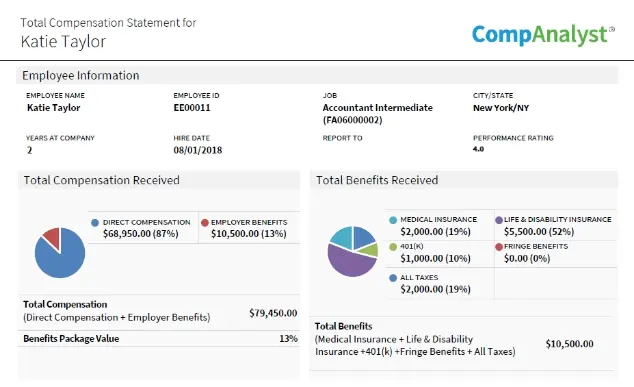Total Rewards Statement: Meanings, Examples and Templates
Keeping employees is a common challenge for many organizations today. A major factor contributing to this challenge is the lack of transparency in communication, which leaves employees uncertain and undervalued. A recent study showed that pay transparency is a key player in employee turnover. Many businesses are now using total rewards communication. This means they give employees a clear breakdown of their compensation, including salary, benefits, and perks.
In this article, discover what total rewards statements are, how to get them, see examples, learn their purpose and benefits, and explore their key components. The goal is to help organizations understand why they are important for their employees.

What is a total rewards statement
A total rewards statement (TRS) is a customized statement that shows the overall value of an employee's job package, not just their salary. It breaks down all parts of their compensation, such as health benefits, paid time off, retirement contributions, and extra perks like discounts.

Components of total rewards statement
A complete total rewards statement typically provides details about different aspects of an employee's pay and benefits. Here are some common components:
Employee Information
This part usually has basic employee information like name, employee ID, job title, and department. It identifies the person receiving the complete rewards statement.
Total Compensation
The Total Compensation section outlines all the money-related aspects that make up an employee's total compensation. This includes:
- Base salary: Regular earnings received by an employee at set intervals.
- Bonus: Additional pay given based on performance, company profits, or specific criteria.
- Commission: Earnings from sales or business brought in by an employee.
- Overtime pay: Extra compensation for hours worked beyond the regular workweek.
- Severance pay: Compensation given to an employee when their job is terminated, usually included in a severance package.
Total Benefits
The Total Benefits section explains the non-money aspects of an employee's compensation, often sharing details about:
- Health Insurance: Covers medical costs and healthcare services.
- Dental Insurance: Covers dental care and procedures.
- Vision Insurance: Includes expenses related to vision care, such as eye exams and glasses.
- Life Insurance: Pays a cash benefit to beneficiaries in the event of an employee's death.
- Disability Insurance: Offers financial support if an employee becomes disabled and cannot work.
- Retirement Savings Plans: Information on employer-sponsored retirement programs like 401(k) or pension plans.
- Paid Time Off: Specifies an employee's entitlement to time off, including vacation days and holidays.
- Employee Assistance Programs (EAPs): Offers support services for personal and work-related issues, such as counseling or legal advice.
Total Rewards Summary
This section puts together all aspects of compensation and benefits into a summary, providing an overall view of the value an employee gets from the company.
Additional Information
This section may contain extra important details or information considered essential for the employee. It might cover things like company rules, special recognitions, or program details that enhance the overall employee experience.
Purpose of total rewards statement
The main purpose of a total rewards statement is to give employees a clear and complete view of everything they get from their job. The statement also aims to:
- Promote transparency A Total Rewards Statement (TRS) removes any confusion about an employee's compensation and benefits by clearly outlining all the components. This transparency builds trust and fosters positive relationships between employees and employers.
- Communicate value Most employees usually only think about their basic salary when tallying their total income. A TRS goes further by highlighting additional benefits like healthcare, retirement savings, paid time off, and others. This helps employees understand the real value of their overall employment package.
- Improve employee awareness Employees often don't know about all the perks they have. A TRS gathers everything in one place, making it easy for employees to discover and use their entitled benefits. This can result in more use of benefits, which can boost employee well-being and satisfaction.
- Support retention and engagement Happy and informed employees are likely to stay with the company. Using a Total Rewards Statement can help retain and engage staff, leading to increased productivity and overall success for the company.
- Attract talent Offering a competitive total rewards package can set companies apart in attracting top talent. By showcasing their complete value proposition, companies can persuade potential candidates that they provide a desirable and satisfying work environment.
Benefits of total rewards statement
Implementing a total rewards strategy in your organization can make a big difference. Here are five key benefits of using total rewards statements:
- Total rewards statement increases employee engagement and work happiness by offering a clear picture of total compensation, which includes salary, benefits, bonuses, and perks.
- TRS makes the organization more appealing to potential candidates while also helping to retain current employees by showcasing complete benefits.
- TRS provides insights about benefit usage, allowing HR professionals to make informed decisions about benefit programs that meet employee needs and preferences.
- Total rewards statement data helps HR make informed decisions that improve employee satisfaction and corporate success.

How to get total rewards statement
Getting a total rewards statement typically relies on your employer's procedures. Here are the general steps to follow to get one:
- Employee self-service portal Companies often offer employee self-service portals or HR information systems (HRIS) for accessing total rewards statements. Employees can log in using their credentials and find details about compensation, including salary, bonuses, health insurance, retirement plans, and other benefits in the designated section.
- Contacting the HR department If your employer lacks an online portal or you face difficulties using it, reach out to your company's Human Resources (HR) department. HR specialists can help provide you with your TRS. You can request this information by visiting the HR office, sending an email, or making a phone call. Be sure to provide any necessary identification or verification information as per your company's rules.
- Annual compensation and benefit statements Some companies provide annual compensation statements during performance evaluations or at the end of the year. These statements outline your total compensation, covering basic salary, bonuses, health benefits, retirement contributions, and other incentives. If your employer follows this practice, you can anticipate receiving the statement at a specific time each year.
Total rewards statement example, sample, template
Below is an example/template of a total rewards statement:
Total Rewards Statement
Employee Information
Name: Belle Constantino
Employee ID: E123456
Hire Date: 01/01/2024
Job Title: Sales Representative
Department: Sales
Direct Compensation
Annual Salary: $100,000
Sales Incentive: $5,000
Bonus: $7,500
Total Compensation: $112,500
Health Benefits
Medical: $4,000
Dental: $1,500
Vision: $800
Life: $100,000 (Life Insurance coverage amount)
Short-Term Disability: $1,200
Long-Term Disability: $2,500
Total Health Benefits: $110,000
Benefits (Mandated)
Social Security: $6,200
Medicare: $1,450
Unemployment Insurance: $500
FUTA Tax: $300
Total Mandated Benefits: $8,450
Retirement Benefits
Retirement Match: $5,000
Paid Time Off
Vacation: 15 days
Holidays: 10 days
Sick Leave: 5 days
Total PTO: 30 days
Total Rewards and Benefits: $235,950
Here's another sample of a total rewards statement, but this time, it's automated with the help of Salary.com’s Compensation Software.

FAQs
Now that you know what a complete rewards statement looks like, let's answer some of the most frequently asked questions about it.

What information is typically included in a total rewards statement?
As mentioned before, a total rewards statement typically covers details about an employee's earnings (salary, bonus, commission) and benefits (health, dental, life insurance, retirement plans, paid time off).
How do you create a total rewards statement?
Create a total rewards statement by collecting employee details like name, start date, job title, and department. Gather data on direct compensation, including salary, bonuses, commissions, overtime pay, and severance benefits. Also, include details about indirect compensation like health, dental, and life insurance, disability benefits, retirement plans, paid time off, and employee assistance programs. Verify accuracy with official payroll and benefits records, and present the information clearly to help employees grasp their overall income and benefits.
When are total rewards statements typically distributed?
Companies usually provide total rewards statements annually, often during performance reviews or the beginning of a new fiscal year. The exact timing varies by company, and some organizations may opt for different intervals to distribute these statements.






